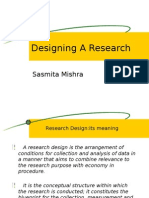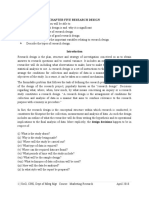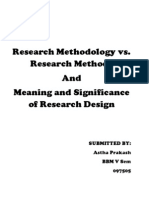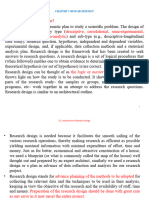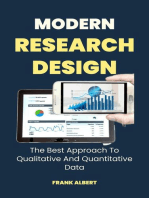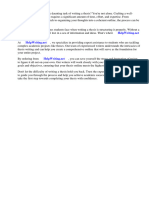Unit 1 BR
Unit 1 BR
Uploaded by
DrRitesh PatelCopyright:
Available Formats
Unit 1 BR
Unit 1 BR
Uploaded by
DrRitesh PatelOriginal Description:
Original Title
Copyright
Available Formats
Share this document
Did you find this document useful?
Is this content inappropriate?
Report this DocumentCopyright:
Available Formats
Unit 1 BR
Unit 1 BR
Uploaded by
DrRitesh PatelCopyright:
Available Formats
MEANING OF RESEARCH DESIGN The formidable problem that follows the task of defining the research problem is the
preparation of the design of the research project, popularly known as the research design. Decisions regarding what, where, when, how much, by what means concerning an inquiry or a research study constitute a research design. A research design is the arrangement of conditions for collection and analysis of data in a manner that aims to combine relevance to the research purpose with economy in procedure. More explicitly, the design decisions happen to be in respect of: 1. What is the study about? 2. Why is the study being made? 3. Where will the study be carried out? 4. What type of data is required? 5. Where can the required data be found? 6. What periods of time will the study include? 7. What will be the sample design? 8. What techniques of data collection will be used? 9. How will the data be analyzed? 10. In what style will the report be prepared? Keeping in view the above stated design decisions; one may split the overall research design into the following parts: (a) The sampling design which deals with the method of selecting items to be observed for the given study; (b) the observational design which relates to the conditions under which the observations are to be made;
(c) the statistical design which concerns with the question of how many items are to be observed and how the information and data gathered are to be analyzed; and (d) The operational design which deals with the techniques by which the procedures specified in the sampling, statistical and observational designs can be carried out. FEATURES OF A GOOD DESIGN A good design is often characterized by adjectives like flexible, appropriate, efficient, and economical and so on. Generally, the design which minimizes bias and maximizes the reliability of the data collected and analyzed is considered a good design. The design which gives the smallest experimental error is supposed to be the best design in many investigations. Similarly, a design which yields maximal information and provides an opportunity for considering many different aspects of a problem is considered most appropriate and efficient design in respect of many research problems. Thus, the question of good design is related to the purpose or objective of the research problem and also with the nature of the problem to be studied. A design may be quite suitable in one case, but may be found wanting in one respect or the other in the context of some other research problem. One single design cannot serve the purpose of all types of research problems.
You might also like
- Conflict Management StylesDocument3 pagesConflict Management StylesrikradhiNo ratings yet
- Philosophy TextDocument198 pagesPhilosophy TextFellOnEarthNo ratings yet
- Gilmore - 2007-Authentic Materials and Authenticity in Foreign Language LearningDocument23 pagesGilmore - 2007-Authentic Materials and Authenticity in Foreign Language LearningDao Mai Phuong100% (1)
- What You Need To Know About Love Languages and How They Affect Your RelationshipDocument4 pagesWhat You Need To Know About Love Languages and How They Affect Your RelationshipCassondra SiausNo ratings yet
- CEO QuestionnaireDocument5 pagesCEO Questionnairedisha_11_89100% (1)
- Research DesignDocument4 pagesResearch Designxxyz14061No ratings yet
- Chapter Four Research DesignDocument9 pagesChapter Four Research DesigndawitNo ratings yet
- Chapter 3 Research Design and ProposalDocument12 pagesChapter 3 Research Design and ProposalgeletawNo ratings yet
- Erm Unit III NotesDocument12 pagesErm Unit III NotesAdula RajasekharNo ratings yet
- 21 (302) RF Research DesignDocument9 pages21 (302) RF Research DesignKC.LalmumpuiiNo ratings yet
- Lecture-3 On 'Research Design'Document11 pagesLecture-3 On 'Research Design'PRITI DASNo ratings yet
- Chapter ThreeDocument11 pagesChapter ThreeMuhammed YismawNo ratings yet
- Unit 3Document15 pagesUnit 3tumelolenyax10111No ratings yet
- Week 03: Topic-01 Research Design: Research Methodologies Virtual University of PakistanDocument8 pagesWeek 03: Topic-01 Research Design: Research Methodologies Virtual University of PakistanBilal MurshidNo ratings yet
- Designing A ResearchDocument9 pagesDesigning A ResearchDurga Prasad DashNo ratings yet
- Meaning of Research DesignDocument24 pagesMeaning of Research Designvaqas HussainNo ratings yet
- Research DesignDocument7 pagesResearch DesignkashyapNo ratings yet
- Research Methodology Lecture - 6Document14 pagesResearch Methodology Lecture - 6Tasin Safwath ChowdhuryNo ratings yet
- Unit-2 Research DesignDocument20 pagesUnit-2 Research Designtiwarisapana036No ratings yet
- Book ChaptersDocument12 pagesBook ChaptersAbu Ishak ShamimNo ratings yet
- Research DesignDocument12 pagesResearch DesignKiran audinaNo ratings yet
- Chapter 4 Research DesignDocument64 pagesChapter 4 Research DesignfatemaNo ratings yet
- CH 5 Research DesignDocument13 pagesCH 5 Research DesignAwal AhmadNo ratings yet
- Research DesignDocument13 pagesResearch DesignKurama The foxNo ratings yet
- Chapter - 4Document5 pagesChapter - 4tevredeNo ratings yet
- Federal Tvet Institute (Ftveti) Department of ICT: Course Title: Research Method in Technology (It542)Document18 pagesFederal Tvet Institute (Ftveti) Department of ICT: Course Title: Research Method in Technology (It542)Behailu DemissieNo ratings yet
- Research Concept Question 1 AssignmentDocument8 pagesResearch Concept Question 1 AssignmentomondijuelNo ratings yet
- BRM Unit-2Document16 pagesBRM Unit-2Deepa SelvamNo ratings yet
- Unit-III: Research DesignDocument35 pagesUnit-III: Research DesignAleem PashaNo ratings yet
- Resaearch DesignDocument8 pagesResaearch DesignFerl ClariteNo ratings yet
- Research Design AssignmentDocument23 pagesResearch Design AssignmentSudhansu panda75% (4)
- Unit V Part A Research DesignDocument5 pagesUnit V Part A Research DesignAaqib RatherNo ratings yet
- Chapterr 33Document86 pagesChapterr 33demilieNo ratings yet
- Chapterr 3Document115 pagesChapterr 3demilieNo ratings yet
- Research DesignDocument6 pagesResearch Designashwini rotheNo ratings yet
- Research Design: Definition, Types and CharacteristicsDocument12 pagesResearch Design: Definition, Types and CharacteristicsShivani Kumari100% (1)
- PGCRSM-01-BLOCK-03 Research Design ExperimentalDocument29 pagesPGCRSM-01-BLOCK-03 Research Design ExperimentalVijilan Parayil VijayanNo ratings yet
- CH 5 Research DesignDocument14 pagesCH 5 Research DesignrezikaabdulkadirNo ratings yet
- Dhirendra CP MetarialDocument4 pagesDhirendra CP MetarialSuraj SinghNo ratings yet
- Research Methodology vs. Research Methods and Meaning and Significance of Research DesignDocument5 pagesResearch Methodology vs. Research Methods and Meaning and Significance of Research DesignMahima SharanNo ratings yet
- Chapter 3Document15 pagesChapter 3Tibebu SeworeNo ratings yet
- Unit 3. Research DesignDocument42 pagesUnit 3. Research Designtebebe solomonNo ratings yet
- CH4 @research and Sampling Design @2018Document14 pagesCH4 @research and Sampling Design @2018Merga MekonninNo ratings yet
- Research DesignDocument19 pagesResearch DesignSHIVANGI ARORANo ratings yet
- Quantitative ResearchDocument14 pagesQuantitative Researchsabahat shireenNo ratings yet
- Chap 4Document6 pagesChap 4Milkias MuseNo ratings yet
- Research DesignDocument61 pagesResearch DesignEyasu Tesfa's SonNo ratings yet
- RESEARCH DESIGN - EditedDocument18 pagesRESEARCH DESIGN - EditedsalesNo ratings yet
- ResearchMethodologyModule3 1Document20 pagesResearchMethodologyModule3 1LIKITH LIKITHNo ratings yet
- Research Design: Construction Management ChairDocument35 pagesResearch Design: Construction Management ChairHayelom Tadesse GebreNo ratings yet
- Concept of Research Design, MBA-IIDocument3 pagesConcept of Research Design, MBA-IItéma bbNo ratings yet
- Chapter 4 Research MTHDDocument39 pagesChapter 4 Research MTHDsamson DawitNo ratings yet
- Various Components of Research DesignDocument7 pagesVarious Components of Research Designtony sarao33% (3)
- Research DesignDocument61 pagesResearch DesignJamaine Jane GlovaNo ratings yet
- RM Mod3Document20 pagesRM Mod3bhoomibhaskar23No ratings yet
- 101 Experimental DesignDocument17 pages101 Experimental DesignShital PatelNo ratings yet
- Research Design Definition 2Document34 pagesResearch Design Definition 2shashankvats26No ratings yet
- Research DesignDocument61 pagesResearch DesignMuhammad NaeemNo ratings yet
- Chapter V (1) ResearchDocument41 pagesChapter V (1) ResearchHabtamu GaromaNo ratings yet
- Chapter 4 - Research DesignDocument34 pagesChapter 4 - Research DesignAliyan AmanNo ratings yet
- Research DesignDocument20 pagesResearch DesignShubham SinghNo ratings yet
- Chapter 4: Research Design Meaning of Research DesignDocument63 pagesChapter 4: Research Design Meaning of Research DesignBilisuma chimdesaNo ratings yet
- Module - 4Document12 pagesModule - 4Chhatrasal Singh TanwarNo ratings yet
- Modern Research Design: The Best Approach To Qualitative And Quantitative DataFrom EverandModern Research Design: The Best Approach To Qualitative And Quantitative DataNo ratings yet
- Financial Statement AnalysisDocument98 pagesFinancial Statement AnalysisDrRitesh PatelNo ratings yet
- Introduction To Wi-Fi: A) Define Wi-Fi B) Applications of Wi-Fi C) Advantages of Wi-FiDocument4 pagesIntroduction To Wi-Fi: A) Define Wi-Fi B) Applications of Wi-Fi C) Advantages of Wi-FiDrRitesh PatelNo ratings yet
- Limited Corporate Identity Number:: Muthoot MicrofinDocument450 pagesLimited Corporate Identity Number:: Muthoot MicrofinDrRitesh PatelNo ratings yet
- The Factor, Which Have Contribute Towards The Development of International AccountingDocument1 pageThe Factor, Which Have Contribute Towards The Development of International AccountingDrRitesh PatelNo ratings yet
- AssessmentX - Candidate ReportDocument1 pageAssessmentX - Candidate ReportDrRitesh PatelNo ratings yet
- Banking Regulation Act, 1949Document50 pagesBanking Regulation Act, 1949DrRitesh PatelNo ratings yet
- Case StudyDocument7 pagesCase StudyDrRitesh PatelNo ratings yet
- 1000 Questions AnswersDocument9 pages1000 Questions AnswersDrRitesh PatelNo ratings yet
- SwotDocument7 pagesSwotDrRitesh PatelNo ratings yet
- Unit 4 FFFDocument25 pagesUnit 4 FFFDrRitesh PatelNo ratings yet
- AmulDocument88 pagesAmulDrRitesh PatelNo ratings yet
- UM04CBBA04 - 09 - Statistics For Management IIDocument2 pagesUM04CBBA04 - 09 - Statistics For Management IIDrRitesh PatelNo ratings yet
- Question Bank For Prinpciple and Practices of Accounting (Ppa) Class: Fybba (HM/TTM)Document1 pageQuestion Bank For Prinpciple and Practices of Accounting (Ppa) Class: Fybba (HM/TTM)DrRitesh PatelNo ratings yet
- Junior Officer Officer Assistant Vice President: Affix Recent Passport Size Photograph Duly SignedDocument2 pagesJunior Officer Officer Assistant Vice President: Affix Recent Passport Size Photograph Duly SignedDrRitesh PatelNo ratings yet
- Current Affairs 2014Document45 pagesCurrent Affairs 2014DrRitesh PatelNo ratings yet
- Families Kinship and DescentDocument42 pagesFamilies Kinship and DescentAnn Marie Palahang100% (1)
- Task - 1 - Reading StrategiesDocument5 pagesTask - 1 - Reading Strategies113 Regina Astarini SoedarsonoNo ratings yet
- Types of Speeches According To DeliveryDocument28 pagesTypes of Speeches According To DeliveryHaumea SamaNo ratings yet
- Eng101 MCQSDocument21 pagesEng101 MCQSKhan SahabNo ratings yet
- Translation of Integrative Behavioral Couple Therapy To A Web-Based InterventionDocument15 pagesTranslation of Integrative Behavioral Couple Therapy To A Web-Based InterventionAna Gonzalez RosaNo ratings yet
- NET ExamDocument32 pagesNET ExammajhiajitNo ratings yet
- Top 10 Chief Marketing Officer Interview Questions and AnswersDocument17 pagesTop 10 Chief Marketing Officer Interview Questions and AnswersJayashree MenonNo ratings yet
- Lewicki Negotiation 9e PPT Ch10 ACCESSDocument21 pagesLewicki Negotiation 9e PPT Ch10 ACCESSArun SudhakaranNo ratings yet
- Effective ListeningDocument15 pagesEffective Listeningapi-3706009100% (2)
- Post Marital Life in Indian AstrologyDocument2 pagesPost Marital Life in Indian Astrologydashingdude4everNo ratings yet
- CoparDocument43 pagesCoparDthird Mendoza ClaudioNo ratings yet
- COMM 162 - Reading and Writing Test 3Document11 pagesCOMM 162 - Reading and Writing Test 3Karlos SoteloNo ratings yet
- Thesis Outline Format UplbDocument5 pagesThesis Outline Format Uplbafktmeiehcakts100% (2)
- Do Men Make Better Bosses Than Women?Document3 pagesDo Men Make Better Bosses Than Women?mrtltndsNo ratings yet
- Phân Biệt 3 Dạng Bài Advantage and PositiveDocument3 pagesPhân Biệt 3 Dạng Bài Advantage and PositiveMai Phương LêNo ratings yet
- What Is The Importance of Motivation As A Management SkillDocument6 pagesWhat Is The Importance of Motivation As A Management SkillsmelonfNo ratings yet
- Essay PlanDocument2 pagesEssay Plan19281565No ratings yet
- Factors That Influence Postpartum RecoveryDocument2 pagesFactors That Influence Postpartum RecoveryHelenice Assis VespasianoNo ratings yet
- 12th Bio Botany Blue PrintDocument3 pages12th Bio Botany Blue PrintJayaprakash JpNo ratings yet
- De Thi Thankhao-K12 Hki-LqdDocument15 pagesDe Thi Thankhao-K12 Hki-LqdHongLyNo ratings yet
- Behavioural Brain Research: ReviewDocument15 pagesBehavioural Brain Research: ReviewVazia Rahma HandikaNo ratings yet
- NRPU Old PolicyDocument18 pagesNRPU Old PolicyMuhammad Umer FarooqNo ratings yet
- Qualitative Vs QuantitativeDocument30 pagesQualitative Vs QuantitativeMeet SavkarNo ratings yet
- Francis Hung's Resume in DetailsDocument8 pagesFrancis Hung's Resume in DetailsFrancis HùngNo ratings yet














